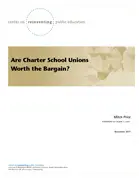About 12 percent of all charter schools have bargaining agreements. Why do charter schools unionize? What is in these charter school contracts? Can they be considered innovative or models for union reform? And how do they compare to traditional district/union teacher contracts? Center on Reinventing Public Education legal analyst Mitch Price investigated those questions in his study of charter school collective bargaining agreements.
Price examined nine charter schools unionized either by management design or by teacher vote. For comparison, he examined traditional district contracts and analyzed data from non-unionized charter schools as well. He found that the new contracts can be crafted in ways that respect the unique missions and priorities of charter schools, provide teachers with basic protections, and maintain organizational flexibility. However, while these new contracts innovate in many ways, they could go much further given the opportunity to create contracts from scratch.
Collective bargaining agreements examined for this study:
- Amber Charter School
- Camino Nuevo Charter Academy
- Civitas Schools
- Conservatory Lab Charter School
- Granada Hills Charter High School
- Green Dot Public Schools
- Green Dot New York Charter School
- Pembroke Pines
- Union Park High Schools





